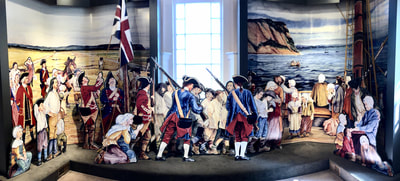Halifax, Nova Scotia to Saint John, New Brunswick: Acadians and the Bay of Fundy Monday, August 6, we departed the Atlantica Hotel, Halifax, Nova Scotia at 8:30, heading for Saint John, New Brunswick.
Our first stop was at the Grand-Pré National Historical Site, which is an interpretive center and a UNESCO World Heritage Site. It features the Acadian people who settled in the Minas Basin shore, which is a tidal marshland called Acadie. The Acadians were French Catholics from the western part of central France. They first came to this new land in the early 1630s. They lived there peacefully until 1755 and the beginning of the Seven Years War between the French and the British. The Acadians would not pledge allegiance to either side so the British attacked them and then deported the survivors. They were sent to the British Colonies from Massachusetts south to Georgia. Some were sent to England and some even back to France. Eventually a number ended up in Louisiana and today are known a Cajuns. The movie we watched at the center helped us understand the significance of this huge deportation. Afterward we had time to walk around the grounds and visit a small memorial church with a beautiful stained glass window. Evangeline: A Tale of Acadie, by Henry Wadsworth Longfellow, (1847) represents the deportation and the resiliency of the Acadian people. After a short stop in Wolfville for lunch, and a quick look at a muddy area which fills when the tide is in on the Bay of Fundy, we continued on. We made a short stop at the Annapolis Tidal Generating Station. This is at a dam where water coming into this arm of the Bay of Fundy, is trapped and held in, then let out, depending on the water level. Letting the water in and out through a turbine that drives a generator, all driven by the fluctuating tide, produces some electricity. We learned a lot about why using this tidal action is difficult. The first generators used were torn apart because of the strength of the tides. Since this is the only place in the world where the tides fluctuate 70 feet every 12 hours and 25 minutes, there isn’t a call for companies to make the kind of turbines and generators needed. So few are made and they are expensive. It was interesting, and we also watched some chick ospreys on a pole right outside the building. We arrived in Digby on the north coast of Nova Scotia in time to board the bus onto the ferry MV Fundy Rose at 5:30 for the two and a half hour crossing over to Saint John, New Brunswick. We were able to get dinner aboard while watching for whales. Didn’t see any. On arrival at The Delta Brunswick hotel we checked in and had a good night sleep. The next morning we were to depart for Saint Andrews after a walking tour of the area in Saint John. More about that in the next post. Grace and Paul
0 Comments
Your comment will be posted after it is approved.
Leave a Reply. |
Author
Grace and Paul Pitzer are retired school teachers who love to travel and share their stories and photos with others. Archives
October 2019
Categories |












 RSS Feed
RSS Feed